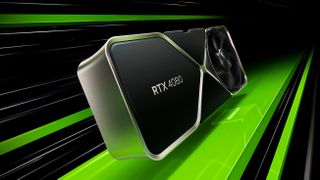RTX 4080 Game Ready Driver Adds Support for G-Sync and V-Sync With DLSS 3
Nvidia is also introducing RTX I/O DirectStorage support and support for the HDR10+ gaming standard

Nvidia has released a new Game Ready Driver — version 526.98, which is jam-packed with feature updates, including support for the RTX 4080, as well as G-Sync and V-Sync support for DLSS 3 frame generation, HDR10+ Gaming, and RTX I/O DirectStorage.
Arguably the most anticipated feature — aside from RTX 4080 support — is official support for V-Sync and Nvidia G-Sync with DLSS 3 frame generation. Support for these two frame-syncing technologies was noticeably absent during the initial release of DLSS 3, but it's finally here with the new 526.98 driver — giving gamers a tear-free experience with frame generation enabled.
That said, support isn't as liberal as we hoped. For now, it's limited to the Nvidia driver version of V-Sync, rather than in-game implementation. This means you have to go to the Nvidia Control Panel and manually enable V-Sync within the 3D settings profile the game you're playing (or enable it globally).
G-Sync support is more straightforward, and only requires the tech to be enabled in the control panel once. DLSS 3 support of G-Sync works for both G-Sync Compatible and G-Sync Ultimate displays. If you still have tearing problems, you can enable V-Sync (manually) in combination with G-Sync.
For those worried about increased input lag, Nvidia says DLSS 3's combination with Nvidia Reflex technology will help decrease input lag even with V-Sync enabled. However we suspect you'll still see slightly higher input lag due to the way V-Sync works.
RTX I/O GPU Decompression Update
The next major feature is support for Microsoft's DirectStorage 1.1 API, in the form of RTX I/O. This feature allows RTX GPUs to comply with the DirectStorage standard, which lets them decompress and load game assets directly from high speed storage solutions with aid from the CPU. This will significantly decrease game load times in titles that support the technology.
RTX I/O's feature set will also extend past Microsoft's DirectStorage API in the form of Vulkan extensions. These extensions will give Vulkan-based titles access to the same performance enhancements as DirectStorage while bypassing Microsoft requirements such as Windows 10, 11, and DirectX 12.
Stay on the Cutting Edge
Join the experts who read Tom's Hardware for the inside track on enthusiast PC tech news — and have for over 25 years. We'll send breaking news and in-depth reviews of CPUs, GPUs, AI, maker hardware and more straight to your inbox.
HDR10+ Gaming Standard
Another gaming focused update in driver 526.98 is support for the HDR10+ Gaming standard. This new standard is an enhanced version of HDR10+ designed specifically for video games that adds Source Side Tone Mapping, auto calibration, and an automatic low-latency mode for TVs. Nvidia says this new feature is especially beneficial for games, since games can query HDR Luminance and color information directly from the display. This ensures the color reproduction of HDR10+ is perfectly produced no matter how strong or weak the display's HDR properties.
For HDR10+ gaming support to work, you'll need a GTX 16 series GPU or a GeForce RTX GPU, as well as a certified HDR gaming display.
Game Ready, Monitor Support, and CUDA 12
Finally, driver 526.98 features Game Ready support for several new titles, support for G-Sync Compatible displays, and support for CUDA 12.
Game Ready support includes the upcoming Spider-Man: Miles Morales, WarHammer 40,000: Darktide, WRC Generations, and World of Warcraft: Dragonflight. There's alao a DLAA update for Monster Hunter Rise.
Monitor support includes 12 new displays from Philips, Eve, Corsair, Asus, and AOC. Ten of these monitors are 27- and 32-inch IPS and OLED panels with 144 Hz to 280 Hz refresh rates, while the other two are OLED TVs (ranging from 48 inches to 77 inches) with up to 120 Hz refresh rates at 4K resolution..
For more details, check out Nvidia's full patch notes here.

Aaron Klotz is a freelance writer for Tom’s Hardware US, covering news topics related to computer hardware such as CPUs, and graphics cards.
Most Popular



